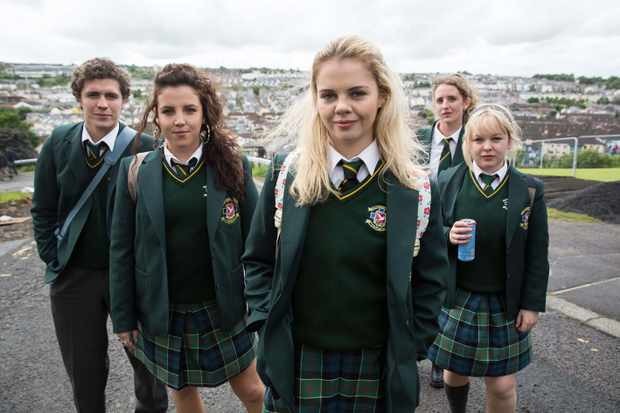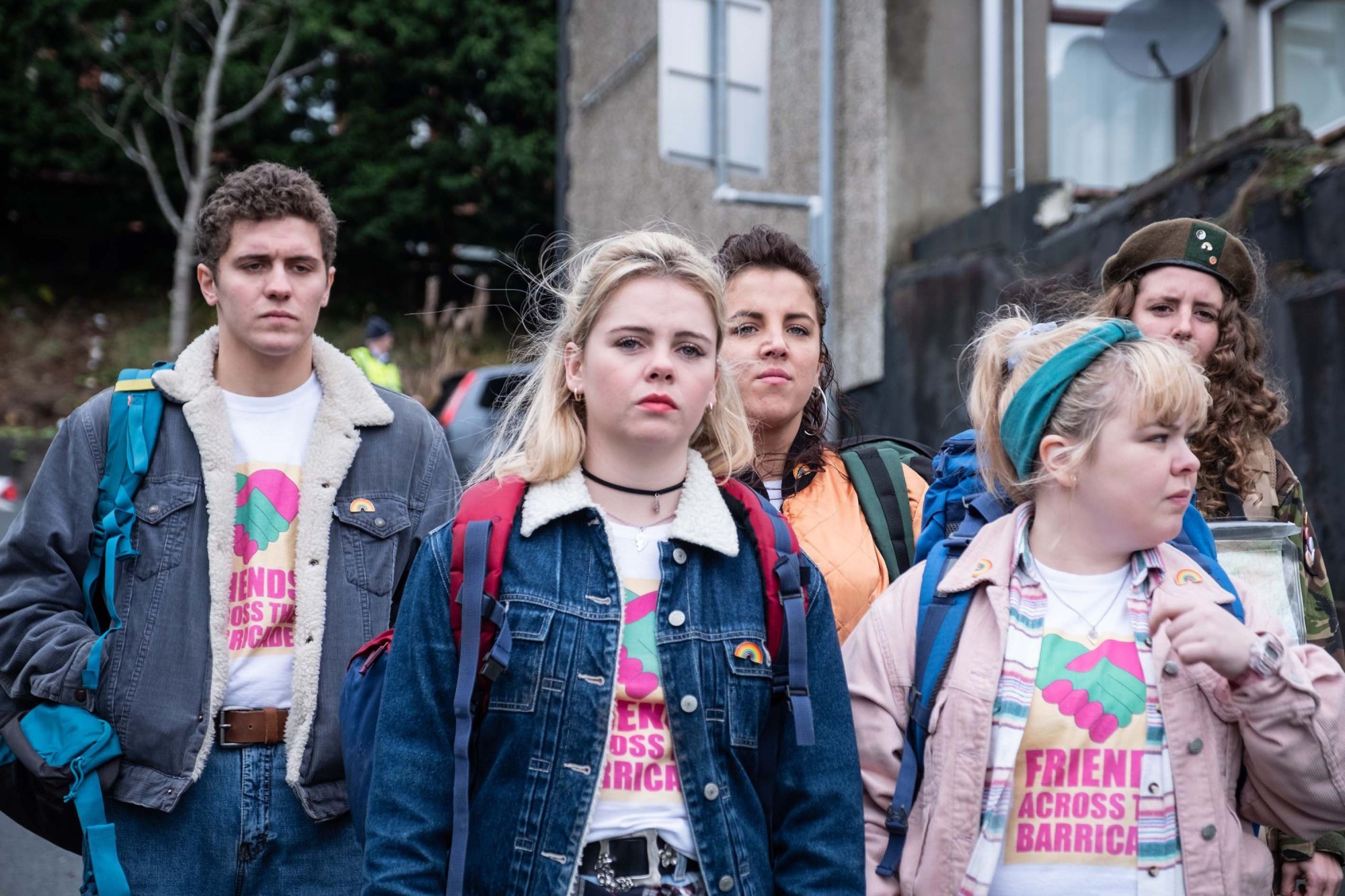I’ll admit it; last year, when one of my (English) friends told me that a new comedy was premiering about life as a teenager in Northern Ireland, I was less than enthusiastic. As someone who grew up in Belfast in the nineties and noughties, the instinct to be embarrassed by our depiction on TV is ingrained in my very soul. From obvious and cringeworthy Troubles comedies like Give My Head Peace to endless morose dramas about the IRA — including all male casts of British and American actors with accents that are invariably nails down a chalkboard bad — the general rule is that telly from the North of Ireland is absolute trash. Despite this, I gave Derry Girls a go, and found it’s actually an absolute geg. I actually laughed. Considering that Northern Irish people are generally considered ethnically joyless, that’s a big deal!
If, for some reason, you haven’t yet managed to catch the greatest show on British (and Irish) TV yet, here’s a Derry Girls crash course. The series follows the lives of Erin Quinn and her group of school friends at Lady Immaculate College — cousin Orla, Michelle, Clare and English exchange student-cum-fish out of water James. 16-year-old Erin, who sees herself as Derry’s future literary genius, is frequently brought down to earth with a bump, either because of her friends or her noisy, hilarious family, but more often because of her own scheming and misadventures. Set in the nineties, the show is a classic nostalgic teen set up, with the added complication that Erin and her friends and family are growing up against the backdrop of the Northern Irish Troubles, a thirty year conflict which took the lives of over 3,000 people before a peace agreement was eventually signed in 1998, bringing an end to (most of) the violence.
I’m not alone in thinking that the series broke the mould for Northern Irish TV. At a recent premiere for the second series of the comedy, a Channel 4 representative revealed that Derry Girls is not only the most watched comedy show on the channel since 2004, it’s also the most watched TV show in Northern Ireland ever. Like, more than Strictly. More than Stephen Nolan! It’s testament to how good the writing is that the show has been wholeheartedly embraced by Northern Ireland and by Derry itself. Years of media which presented the province as a depressing warzone — often focusing on Bloody Sunday, when British forces opened fire on unarmed civil rights protestors marching in the city, killing 14 people — or which pokes fun at the expense of its citizens has hardened the North, and we’re suspicious and reluctant to embrace new representations of ourselves. But Lisa McGee’s nostalgic comedy, which follows the adventures of four Derry schoolgirls (and one Wee English Fella, as they dub him), has been embraced so wholeheartedly that a mural has been created in honour of the show in Derry. And we love murals! Another huge deal!
The second series, which premiered last night, was the first time ever that Channel 4 had aired a comedy in the 9.15 slot, after their flagship Bake Off special. Showing the girls of our Lady Immaculate College embark on a cross-community “smashing the barricades” field trip with a bunch of gormless Protestant boys, it was immediately lauded as a triumphant return, watched by 1.8 million people.
So, what is it about Derry Girls which smashes records and subverts expectations? A lot of the success of the show undoubtedly comes down to the writing. Lisa McGee, the brains behind London Irish and Being Human, has with Erin, Orla, Clare and Michelle created Irish female characters that are not only well-rounded, flawed and interesting, but are genuinely funny. Lisa’s characters are the TV equivalent of Ireland’s recent upsurge of complicated young female characters in literature, led by authors like Sally Rooney and Anna Burns. If that sounds unremarkable, it’s only noteworthy because, in the canon of Irish media, women, especially young, working class women, are rarely if ever allowed to be funny. Most Irish female characters are tragic victims of either the Catholic Church or the British Government. They’re terrorism widows, ‘fallen women’, impoverished and desperate.
“Not to discount those stories, but it’s always really annoyed me,” Lisa told i-D of the tendency to represent Irish female characters as victims. “It’s always annoyed me because the women in Northern Ireland and Irish women are so funny. They’re always [seen as] victims, always victims of something to do with the political situation or the Catholic Church. Those stories are dead important and we need to see them and hear them. I just think there needs to be joy as well. We need to be allowed to tell the stories that other people from around the world are allowed to tell.”
Derry Girls steps right into that chasm of joy, but let’s be honest, its success isn’t purely down to providing representation for the people of the North of Ireland. Since its inception in 2018, the show has become a sensation not just in Ireland and Britain but in the rest of the world too. In December Derry Girls was acquired by Netflix US, making its American debut less than a year after Channel 4 executives worried that audiences in the UK both wouldn’t ‘get’ the show’s humour and — worse still — wouldn’t understand the characters’ accents. And the Americans, for their part, embraced it wholeheartedly (and not even in that really annoying “yeah, we’re Irish Americans! Happy St Patty’s Day! Let me mispronounce words in Irish to you!” way). “Derry Girls is friggin’ hilarious,” one US fan wrote on Twitter. “I’m praying I don’t give into any temptation to turn on subtitles.” “Just finished Derry Girls and it was amazing. So pissed there are only six twenty minute episodes but anyway it’s hilarious,” tweeted another. They took it to their hearts, like a more aggressive, less chic Gossip Girl. Like Skins without the pingers and rich parents. Which makes sense, because at its heart Derry Girls is a show not about the Irish question but about being a teenager, just like Skins or Gossip Girl.

While it undeniably captures how esoteric Northern Irish humour can be, Derry Girls is a success simply because it’s a well written show about the daily embarrassments and escapades that come with being a teenage girl. The fact that it’s set in the 90s, an era that collectively our nostalgia for is seemingly never ending, obviously helps. But it’s so easy, with both writing about a teenager and writing about the 90s, to go overboard; all bucket hats and jokes about fingering. Lisa McGee resists the temptation to go over the top, and so the Cranberries and Whigfield tracks, the denim jackets and slouchy school socks and even the way the characters talk to each other — in one episode Clare breaks down and screams at the others that she is “not a craic killer!”, giving me immediate war flashbacks to being an extremely wet tee-total teenager — seem genuine and authentic, rather than hackneyed and over the top. You can watch the show because it reminds you of Northern Ireland, but you can also watch it because it’s just an exceptionally well written, funny representation of how tragic you were growing up.
Northern Irish culture by its very nature is not celebratory. In fact it’s usually considered quite conservative (big thanks to the DUP for that stereotype! Hey huns x). But Derry Girls shows that that stereotype is not the only thing the region has to offer. It’s also, after just one episode of the second season, helping people to understand my accent a little bit better. So if it could be renewed for another 10 series that would be great, ‘hanks.
